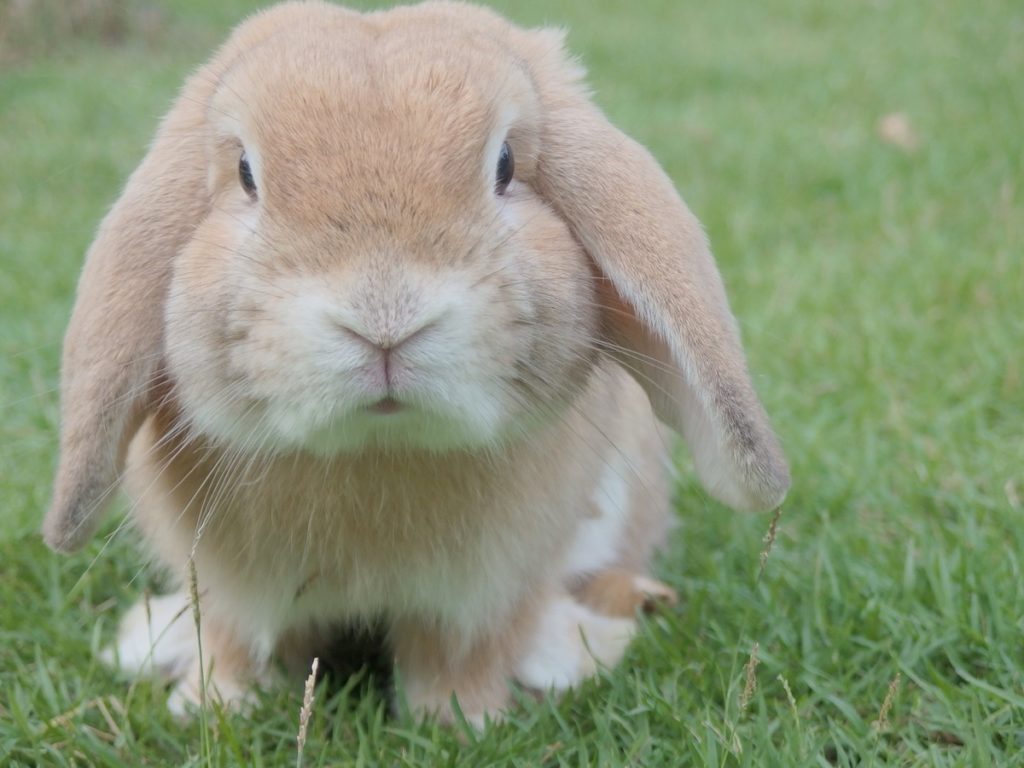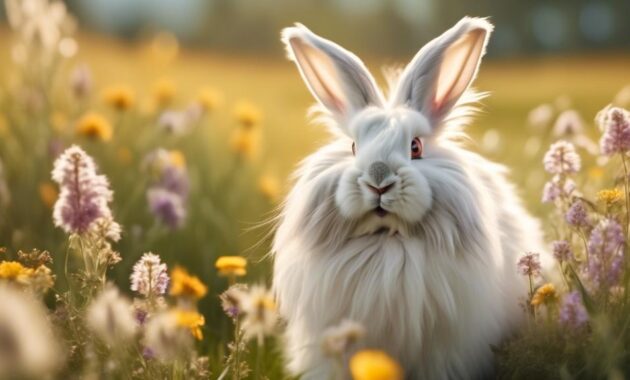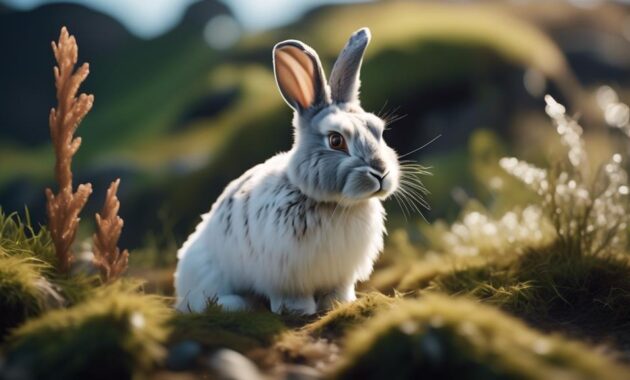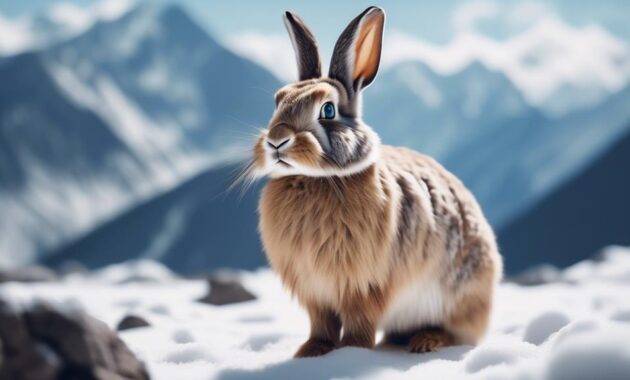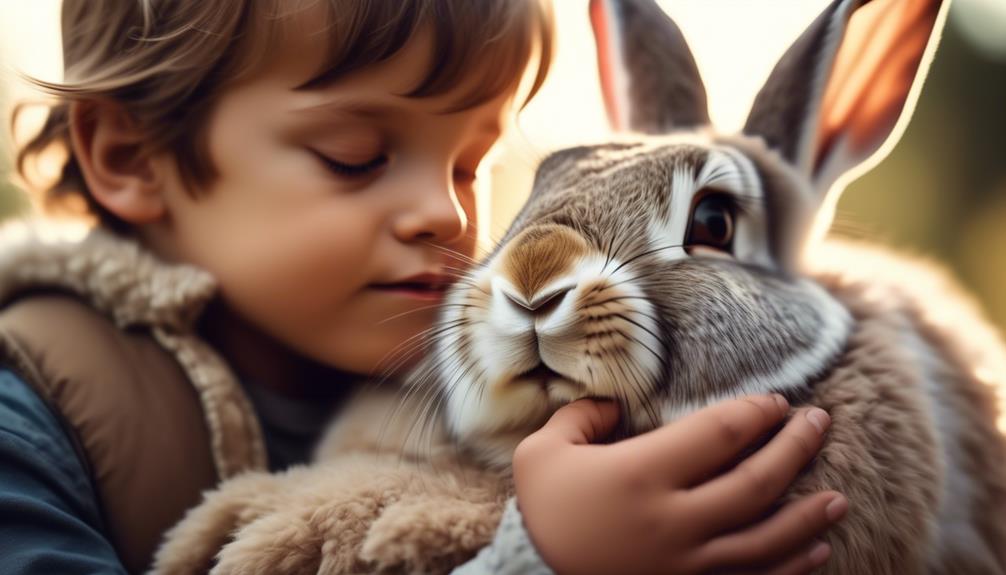
Ready to dive into the fascinating world of giant rabbits? Prepare to be captivated by a breed that boasts a surprising temperament like no other. These gentle giants have a lot more to offer than just their impressive size and soft fur.
With their curious and active nature, they make wonderful companions for individuals of all ages. But what sets them apart from other rabbit breeds? And how can you foster a positive rabbit-human relationship?
Get ready to uncover these secrets and more as we explore the intriguing world of giant rabbits and their surprising temperament.
Key Takeaways
- Giant rabbits, such as the Checkered Giant breed, have a curious, gentle, sweet, and active temperament.
- Aggression in rabbits is not common, and no particular rabbit breed has aggression as its characteristic trait.
- Factors contributing to aggression in rabbits include mistreatment, health issues, behavioral problems, fear and stress, and hormonal changes.
- Addressing aggression in rabbits involves consulting a veterinarian, providing a safe environment, socializing and training from a young age, considering neutering or spaying, seeking professional help if needed, spending quality time with the rabbit, and educating oneself about rabbit behavior.
Physical Characteristics and Care Requirements
To properly care for giant rabbit breeds, it’s important to understand their physical characteristics and specific care requirements.
Giant rabbits typically weigh between 11-13 pounds and have a lifespan of 5-6 years. They have a semi-arch or mandolin body shape and are considered to be of giant size. Their coat is soft with short to medium-length fur.
When it comes to their enclosure, it should be at least 3 feet by 3 feet by 4 feet, with wire sides and a solid bottom. The bottom should be lined with hay and spot-cleaned daily. Giant rabbits can be kept both indoors and outdoors.
In terms of diet, they require 70% hay, along with pellets, vegetables, and fruits sparingly.
Lifespan and Size
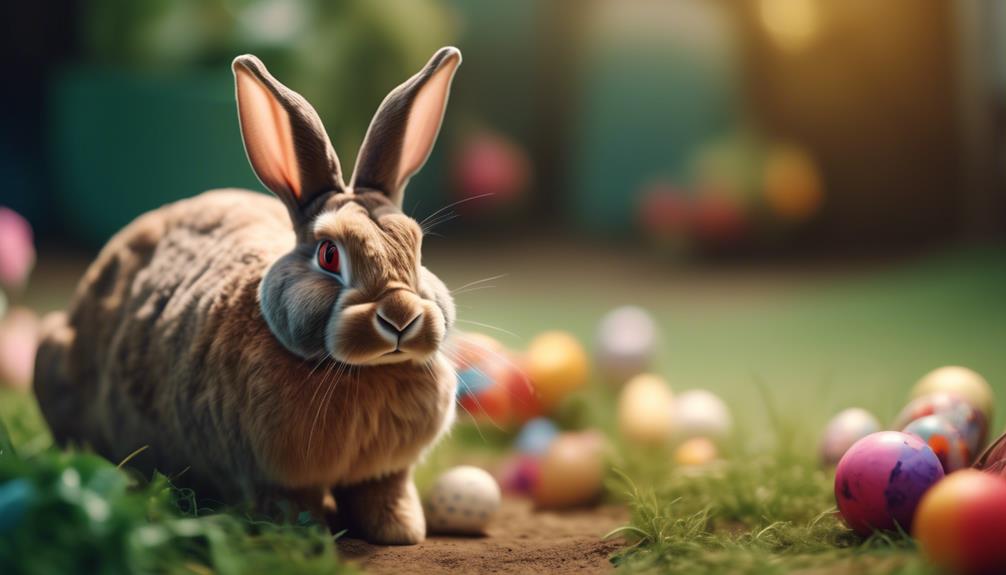
Giant rabbit breeds have a lifespan of 5-6 years and reach a size of 11-13 pounds. These rabbits are known for their impressive size and weight compared to other breeds.
With an average lifespan of 5-6 years, it’s important to provide them with proper care and attention throughout their lives. These rabbits require a large enclosure, measuring at least 3 ft x 3 ft x 4 ft, to accommodate their size and provide them with enough space to move around comfortably.
It’s also essential to provide them with a diet consisting of 70% hay, pellets, and vegetables, with fruits given sparingly. By meeting their specific needs, you can ensure that these gentle giants live a happy and healthy life.
Body Shape and Coat
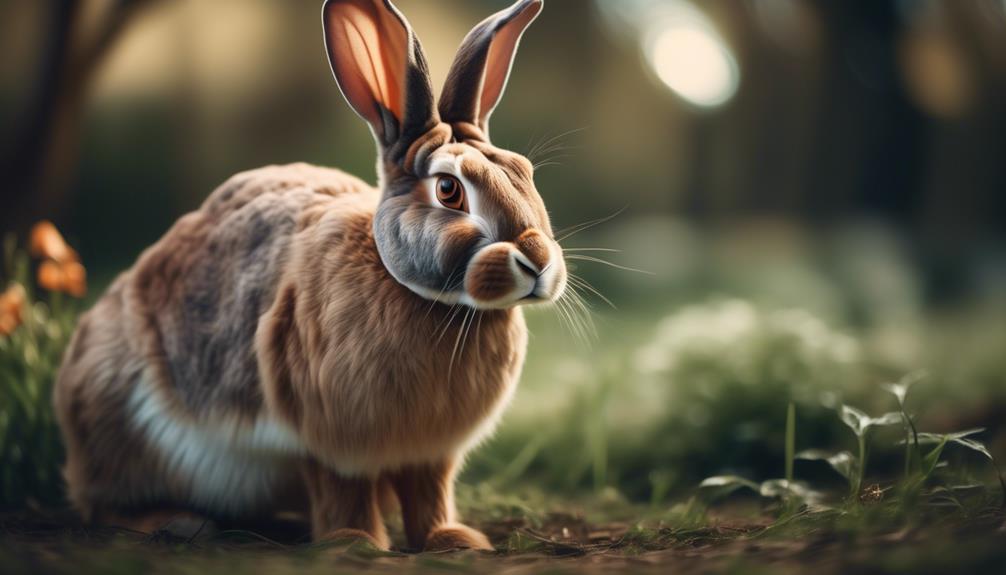
When considering the body shape and coat of giant rabbit breeds, it’s important to note their unique characteristics. Here are three key aspects to visualize:
- Semi-Arch/Mandolin Body Shape: Picture a rabbit with a graceful, arched back that slopes down towards the rear, resembling the shape of a mandolin. This distinctive body shape gives giant rabbits an elegant and regal appearance.
- Soft Short-to-Medium-Length Fur: Envision a rabbit with a plush coat that feels incredibly soft to the touch. The fur of giant rabbits isn’t too long or too short, striking a perfect balance. It provides warmth and comfort while being manageable in terms of grooming.
- Distinctive Markings: Imagine a rabbit with striking patterns and colors. Accepted by the ARBA, white giant rabbits can have blue or black markings. These markings include butterfly-shaped patterns across the nose, two spots on each side of the body, and a black or blue stripe running along the spine. These markings make giant rabbits stand out from other breeds.
Understanding the body shape and coat of giant rabbit breeds allows us to appreciate their unique beauty and characteristics.
Enclosure and Diet
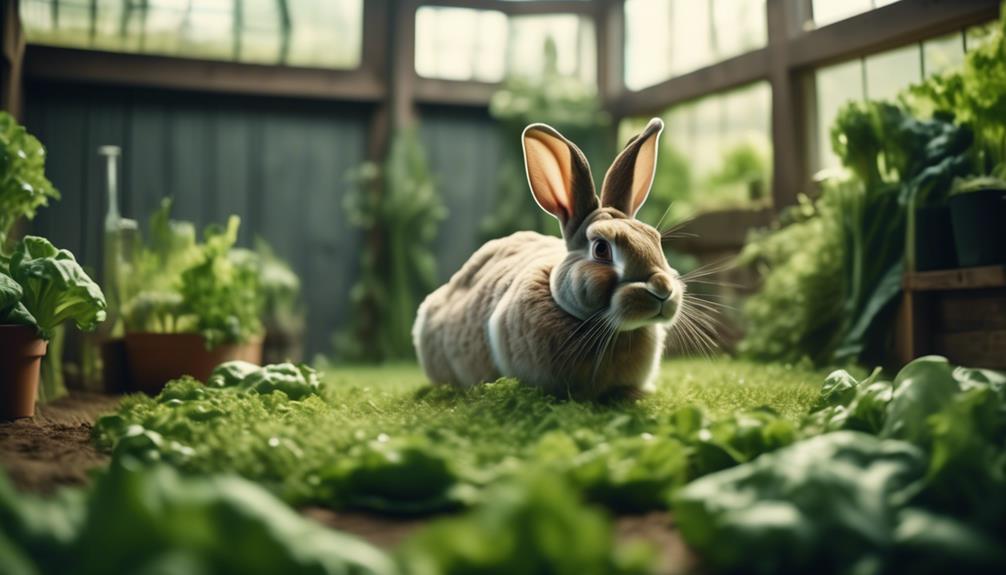
Creating an appropriate enclosure and providing a balanced diet are crucial aspects of caring for giant rabbit breeds.
Giant rabbits require a large enclosure, measuring at least 3 ft x 3 ft x 4 ft, with wire sides and a solid bottom. The bottom should be lined with hay and spot-cleaned daily. This type of enclosure is suitable for both indoor and outdoor living.
When it comes to diet, giant rabbits should be fed a combination of hay, pellets, and vegetables, with fruits given sparingly. The ideal diet consists of 70% hay, which is essential for their dental health.
It’s important to provide a balanced diet to ensure your giant rabbit’s overall well-being and longevity.
Temperament and Breed History
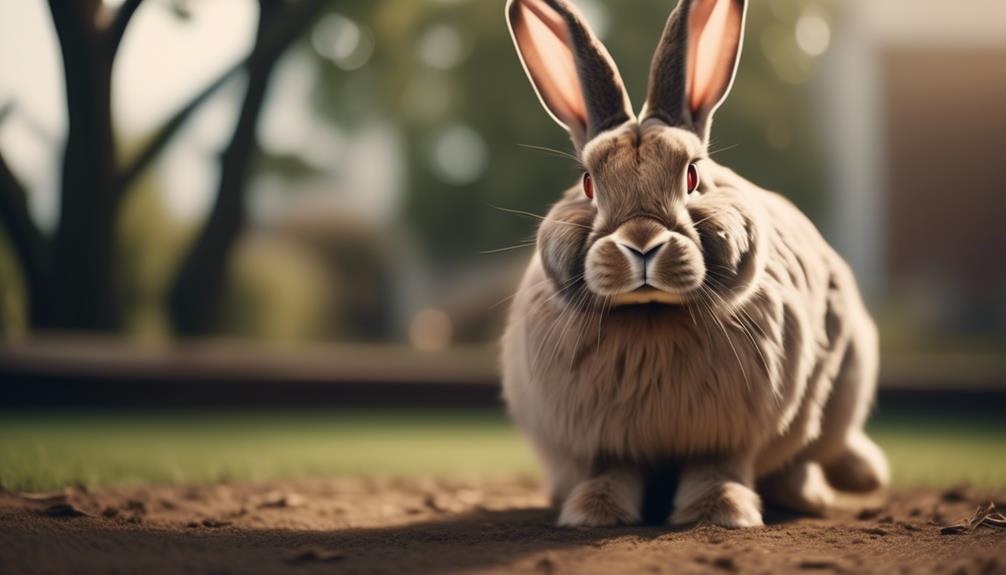
To better understand the temperament and breed history of giant rabbit breeds, it’s important to explore their unique characteristics and origins.
- Giant rabbits have a curious, gentle, sweet, and active temperament, making them suitable for singles, seniors, and families with children.
- The breed’s origin is disputed, with some claiming it originated in France and others in Germany in the 1800s. It was bred from Flemish Giants, French Lops, and spotted rabbits.
- The Checkered Giant, with its distinctive markings, was bred in 1904 by Mr. Otto Reinhardt. The ARBA accepts white with blue or black markings, butterfly markings across the nose, two spots on either side of the body, and a black or blue stripe over the spine.
Understanding the temperament and breed history of giant rabbits can help potential owners make informed decisions about their care and ensure a positive rabbit-human relationship.
Suitable for Different Lifestyles
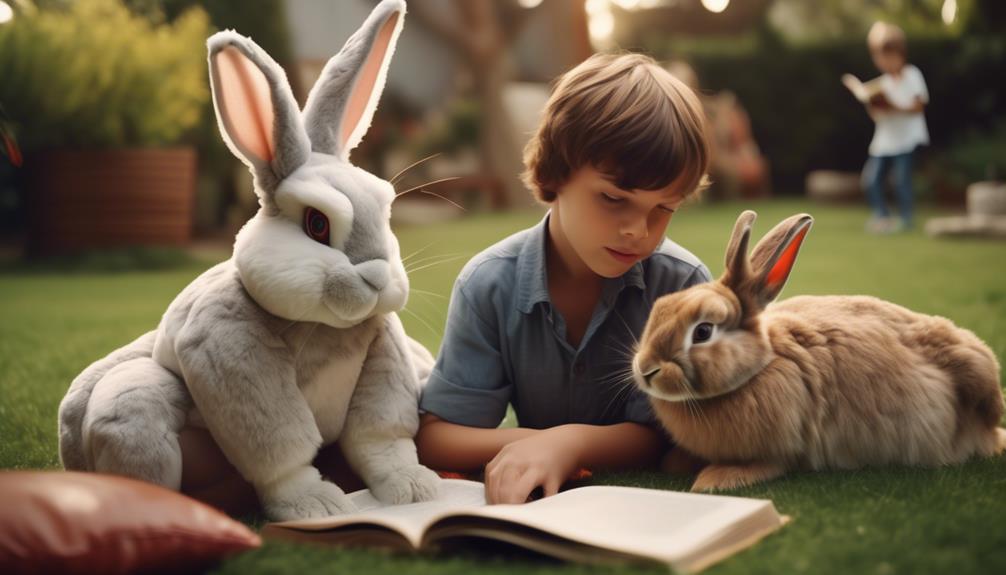
Giant rabbit breeds are adaptable to various lifestyles, making them a versatile choice for potential owners. Whether you’re a single person looking for a cuddly companion, a senior seeking a gentle and low-maintenance pet, or a family with children in need of a friendly and active playmate, these rabbits can fit into your life.
Their curious and sweet temperament makes them suitable for different households. With their medium-sized bodies and soft fur, they can comfortably live both indoors and outdoors. Their large enclosures provide ample space for them to hop around and explore.
Origin and Breeding Process
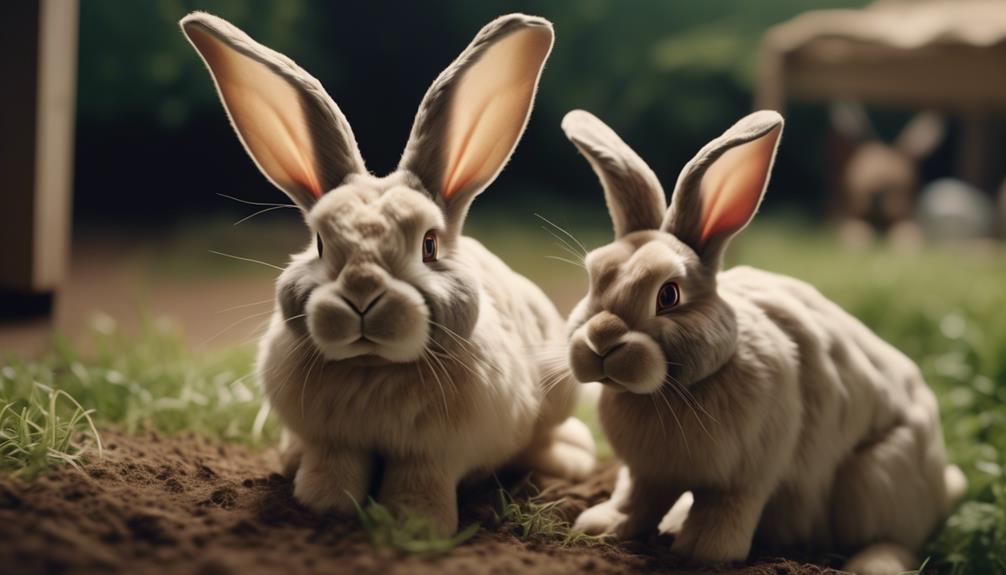
If you’re curious about how these giant rabbit breeds came to be, let’s take a look at their fascinating origin and the breeding process behind them.
Origin Dispute: The exact origin of these giant rabbits is still debated. Some say they were developed in France, while others claim Germany in the 1800s.
Breeding Process: These giant rabbits were created by crossing different breeds. They were bred from Flemish Giants, French Lops, and spotted rabbits. The Land Kaninchen breed, weighing 10-12 lb without markings, was crossed with Flemish Giants to create the Lorraine rabbit. Mr. Otto Reinhardt then bred the Checkered Giant in 1904.
Checkered Giants: This specific breed is accepted by the ARBA in white with blue or black markings. They’ve distinctive butterfly markings across the nose, two spots on either side of the body, and a black or blue stripe over the spine.
Understanding the origin and breeding process of these giant rabbits adds to their allure and unique characteristics.
Colors and Markings
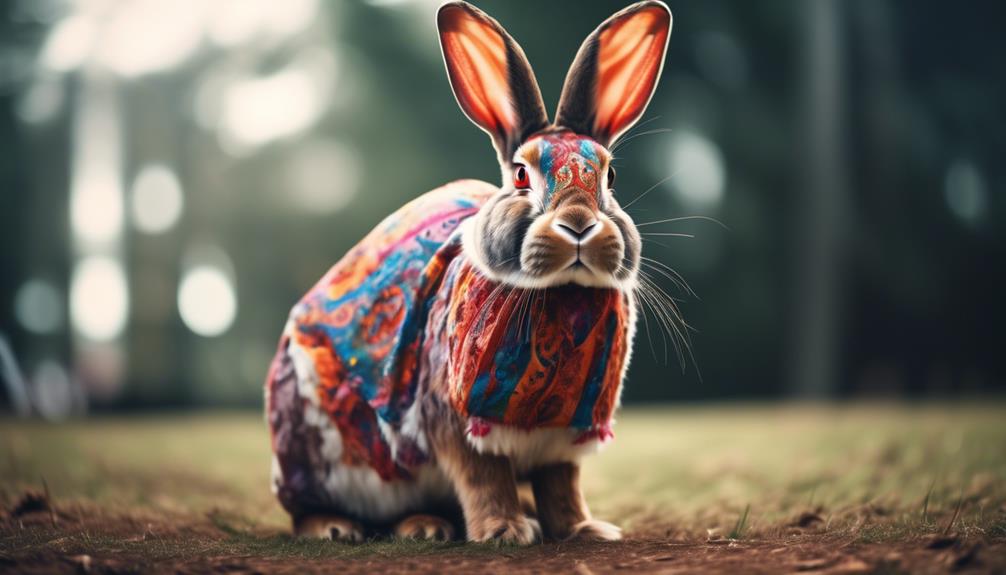
The colors and markings of giant rabbit breeds are distinct and captivating. The American Rabbit Breeders Association (ARBA) accepts giant rabbits with white fur and either blue or black markings. These markings create a unique and eye-catching appearance.
One distinguishing feature is the butterfly markings across the nose, which add a touch of elegance. Additionally, two black or blue spots can be found on either side of the body, along with a black or blue stripe running over the spine. These markings set giant rabbit breeds apart from other rabbit breeds and make them truly stand out.
Whether you choose a giant rabbit with blue or black markings, their appearance is sure to leave a lasting impression.
Aggression in Rabbits
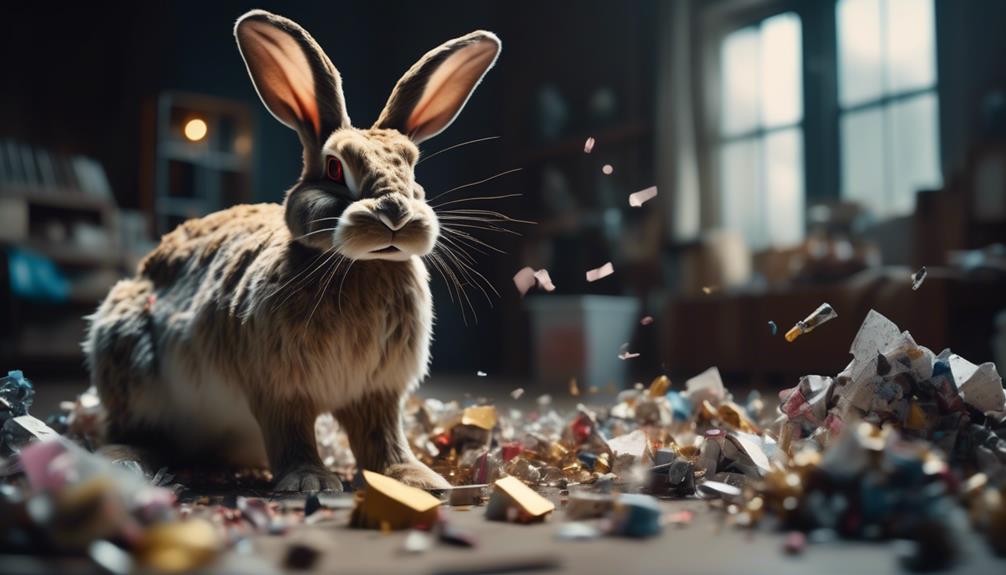
Aggression in rabbits isn’t a common behavior, but it can be influenced by various factors such as mistreatment, health issues, behavioral problems, fear and stress, and hormonal changes.
When it comes to aggression, Checkered Giants can be more energetic and feisty compared to other breeds.
To manage aggression in rabbits and promote a positive rabbit-human relationship, there are several steps you can take.
First, consult a veterinarian to rule out any underlying health issues.
Providing a safe environment that reduces stress and fear is crucial.
Socialization and training from a young age using positive reinforcement techniques can help establish boundaries.
Consider neutering or spaying to manage hormonal aggression.
If aggression persists or escalates, seek professional help.
Spending quality time with your rabbit, offering mental and physical stimulation, and respecting their boundaries will also contribute to a positive relationship.
Educating yourself about rabbit behavior, needs, and communication is essential.
Factors Contributing to Aggression
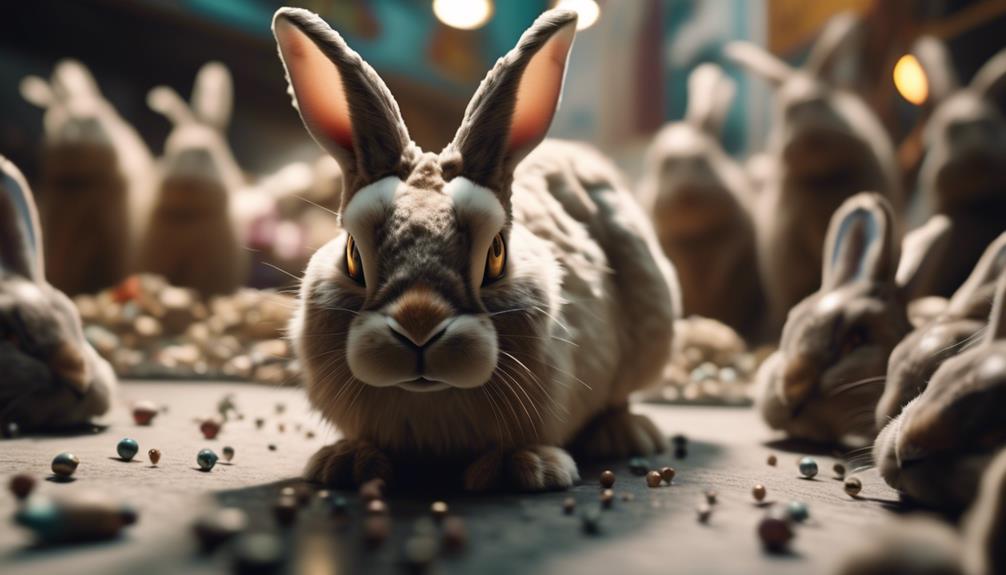
When addressing aggression in rabbits, it’s important to understand the various factors that contribute to this behavior.
Aggression in rabbits isn’t common, and no particular breed has aggression as its characteristic trait. However, there are several factors that can contribute to aggression in rabbits, such as mistreatment, health issues, behavioral problems, fear and stress, and hormonal changes.
It’s worth noting that Checkered Giants, the breed being discussed in this article, can be more energetic and feisty compared to other breeds.
To manage aggression in rabbits, proper socialization, training, and providing ample space and enrichment are crucial. It’s also important to consult a veterinarian to rule out any underlying health issues and consider neutering or spaying to manage hormonal aggression.
If aggression persists or escalates, seeking professional help is recommended.
Promoting a Positive Rabbit-Human Relationship
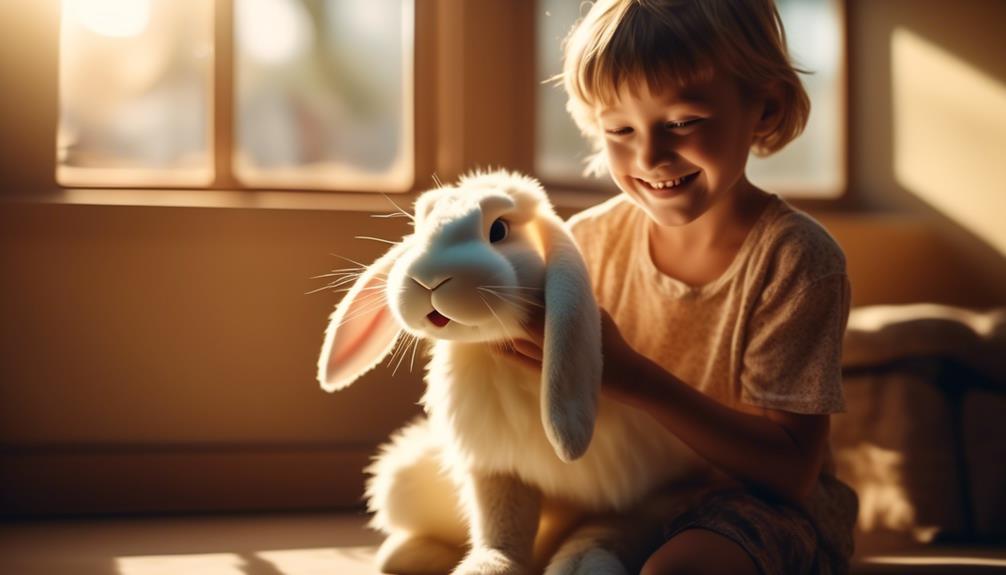
To foster a positive relationship between you and your rabbit, it’s important to establish trust and create a nurturing environment. Here are three key steps to promote a strong bond with your furry companion:
- Spend quality time together: Set aside dedicated time each day to interact and engage with your rabbit. This can include gentle petting, playing with toys, or simply sitting nearby while they explore. By consistently giving your rabbit attention and affection, you’ll build a foundation of trust and companionship.
- Provide a safe and stimulating environment: Ensure that your rabbit’s living space is secure, comfortable, and enriched with toys, hiding spots, and tunnels. This will allow them to actively explore their surroundings and prevent boredom or frustration. A happy and stimulated rabbit is more likely to form a positive bond with their human caregiver.
- Use positive reinforcement: Reward desirable behaviors, such as using the litter box or coming when called, with treats or praise. This positive reinforcement will reinforce good habits and strengthen the bond between you and your rabbit. Avoid punishment or negative reinforcement, as it can damage the trust and relationship you’re trying to build.
Frequently Asked Questions
Can Giant Rabbits Be Litter Trained?
Yes, giant rabbits can be litter trained. Provide a large litter box with rabbit-safe litter and place it in the designated area. Show consistency, reward good behavior, and clean accidents promptly.
How Often Should a Giant Rabbit’s Enclosure Be Cleaned?
You should clean a giant rabbit’s enclosure at least once a day. Spot-clean the bottom lined with hay daily, and do a thorough cleaning of the entire enclosure, including wire sides and solid bottom, as needed.
What Are Some Common Health Issues That Giant Rabbits May Experience?
Giant rabbits, like any other breed, may experience common health issues. It’s important to consult a veterinarian for an accurate diagnosis, but some potential concerns include dental problems, gastrointestinal issues, obesity, and respiratory infections.
Are Giant Rabbits Suitable for Apartment Living?
Yes, giant rabbits can be suitable for apartment living. They have a gentle temperament and can adapt well to indoor environments. Just make sure to provide them with a large enclosure and proper care.
Can Giant Rabbits Be Trained to Do Tricks or Commands?
Yes, giant rabbits can be trained to do tricks or commands. With proper socialization, training, and positive reinforcement techniques, you can teach them various tricks, such as hopping through hoops or coming when called.
What Is the Temperament of the Flemish Giant Rabbit Breed?
The enormous Flemish Giant rabbit breed is known for its gentle and docile temperament. They are friendly and good-natured, making them great pets for families. These rabbits are calm and laid-back, often enjoying being around people. Their easy-going nature makes them ideal for first-time rabbit owners.
Conclusion
In conclusion, owning a giant rabbit as a pet can be a truly rewarding experience. These gentle giants not only have impressive physical characteristics but also possess a sweet and gentle temperament that makes them great companions for people of all ages.
With the right care and attention, giant rabbits can thrive and bring joy to any household. So, if you’re looking for a unique and loving pet, consider adding a giant rabbit to your family.

